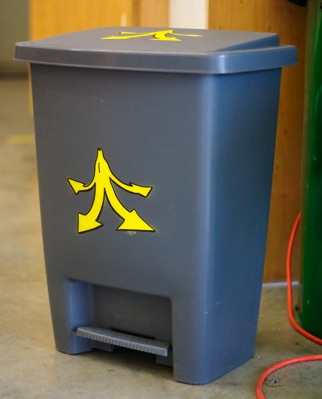Great Logo
First, the best logo I’ve seen in a while:

Design department composting initiative. New logo by ID3 Jonny Hehr (idtreehouse.com). So effective for the obvious: banana speaks compost, arrows speak recycle, colour: highly visible.
Design and BC Wood Industry
Guest designer today in Core Studio. Barbara Bell (formativdesign.com), Vancouver-based consultant / specialist in processed and value-added wood design / research (and trained, incidentally, at the Kootenay School of the Arts in my home town).
One of Bell’s points for us–and her current career–was how designers need to demonstrate the need and value behind infusing our declining wood industry with new shifts in thinking about wood use, manufacturing, marketing, etc. The discussion veered from education to competing with China to niche examples of the value of design as the often sole differentiating factor between competing products.
And while there are organizations currently researching technologies and sciences behind new wood products (see forintek.ca), and monitoring the market for their applications, the component to bridge the two realms, design, is lacking. Which, as I understood it, is where she comes in.
Also, like our Soft Products instructor Catherine Brown mentioned last week: nearly all outdoor tents are made in the same factory in China. So what separates a product when the materials and craftsmanship are the same? Design. And she sees that as a positive thing.
One of the laments I’ve been hearing from professors and designers I meet is that Canada and BC doesn’t showcase its top resource: wood and wood design. Like, when you arrive by air in Helsinki you’re greeted to a showcase of impressive wood-based architecture. Arrive in Vancouver, anywhere in Vancouver, and you see…glass and concrete.

Helsinki Airport: a showcase of Finland’s resource and craft.
I often think of this quote, that designers of the 21st century will not be designing the new but repurposing the detritus of the 20th. So if I had to examine the market and determine where we can create new value in the industry in BC, much as Bell and organizations like Forintek do, I’d want to see how I could easily convert current wood industry infrastructure–the very machines of the lumber and pulp mills and loggers–to manufacture and produce new products. One could even look at how the current labour force’s expertise could be retrained and redirected.
And a discussion on this topic is never complete without mentioning Triton, the underwater logging company a good friend of mine is an engineer at.

Triton Logging harvests trees lost underwater from hydro damn flooding. The lumber has a unique colour highly valued in home construction.
On the whole it sounds like (and I’ve now heard this from at least four designers and business people) the wood industry is more interested in sheer short term survival than pausing to rethink their long term directions and economies. Like a manager of a local designer furniture manufacturing plant told me recently, if it doesn’t involve logs and 2x4s, they don’t want to hear about it in BC.
On Design Education
Asking for and receiving lots of great advice on how to go about organizing two separate design events for the department. Though both projects are rather different the techniques offered to facilitate their success are interchangeable, and apply to design education as a whole, I think.
For example, after talking with a specific design professor tonight:
Don’t evaluate; provide feedback
We’re here to connect with you
Remind them to be themselves
What are the shortcomings you see?
How do we fill these needs?
Give openings
Set the project on fire
Help us
Feel free to shine
Suggest a framework
I use the word ‘license’ to help me understand and remember the gist of all that: give yourself and others license to explore an idea, try a technique, go somewhere and do some thing. One of the lessons I learned in Foundation was to ask What are the myths you tell yourself about yourself. What are the myths others tell you about yourself?
Leave a Reply